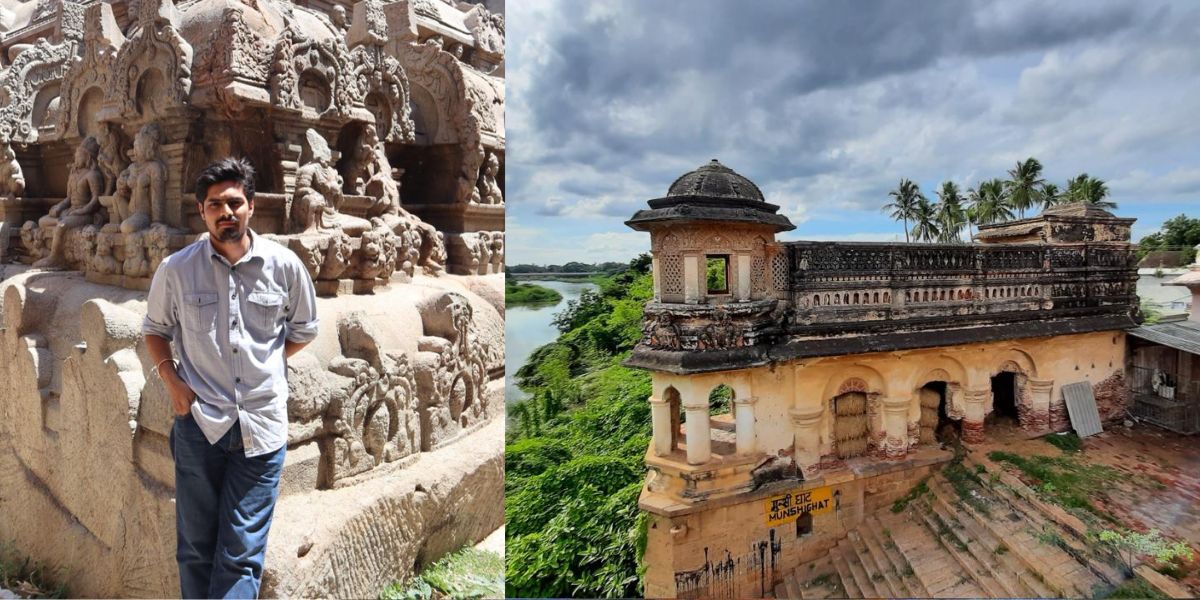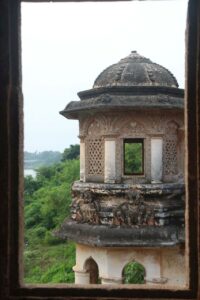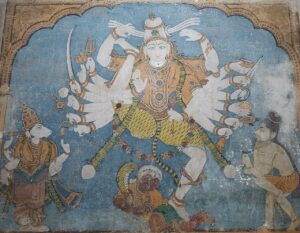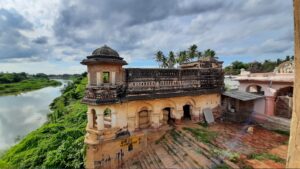Heritage researcher Raghuram SK discusses the best ways to explore hidden gems and lesser-known heritage sites in Thanjavur.

Raghuram's mission is to shine a spotlight on every corner of Thanjavur, diverting attention away from the popular tourist spots towards those in need of recognition. (Supplied)
“I’m fatigued from constantly seeing Instagram Reels and YouTube shorts featuring the Brihadeeswara temple in Thanjavur with the background music from Aayirathil Oruvan (2010),” Raghuram SK begins.
Raghuram, a heritage researcher, currently serving as a project associate at the Indira Gandhi National Centre for the Arts in New Delhi, has dedicated himself to shedding light on the overlooked aspects of his hometown – Thanjavur. Over the past five years, the 25-year-old has been actively sharing information about lesser-known places in the ancient city.
“When people talk about Thanjavur, they usually focus on the Periya Kovil (Brihadeeswara Temple), admiring the Tanjore-style paintings, and perhaps experiencing the Saraswathi Veena. While all these aspects have become the face of the region, there’s so much more to this historic place,” explains Raghuram, a business administration graduate, who pivoted his career after completing PG Diplomas in Heritage Studies from INTACH and Journalism from Bhartiya Vidya Bhavan, New Delhi.
“Growing up in Kumbakonam and Thanjavur, my innate passion for culture, heritage, history, and art was nurtured. My mother’s keen interest in temples only furthered this. So, when I found myself at a crossroads after completing my undergraduate studies, I decided to delve deeper into the cultural realm,” shares Raghuram, who also holds an MA in Museology from the National Museum Institute.

Sandhya Padithurai, Palliagraharam, 18th Century Maratha period Ghat along the river Vennaru. (Supplied)
“Did you know that Thanjavur is home to more than seven museums?” he asks.
The city boasts India’s first Food Museum established by the Food Corporation of India (FCI), the Rajaraja Site Museum in the Rajaraja Manimandapam, the prestigious Saraswathi Mahal Library located within the Thanjavur Palace campus, and the Maharaja Serfoji II Memorial Hall Museum.
“In addition to these, there are four more museums scattered across the city, each housing a wealth of knowledge, history, and heritage, with numerous artefacts and stories waiting to be explored,” he shares.
Inquire about Raghuram’s motivation to explore his hometown from a fresh perspective, he reflects.
“During the early stages of my research journey, I explored the temples in and around the Cauvery delta, making them my focal point. The lockdown imposed during the pandemic presented me with the chance to further explore numerous sites, all while collaborating with an NGO dedicated to cataloguing and documenting heritage sites in the region. This experience, combined with my readings, notably Rajarajeshwaram by historian Kudavayil Balasubramanian, broadened my horizons significantly,” he shares.
Throughout our conversation, it becomes increasingly apparent that Raghuram’s mission is to shine a spotlight on every corner of Thanjavur, diverting attention away from the popular tourist spots towards those in need of recognition.
With over 1200 years of continuous history, Thanjavur holds immense historical significance. “It’s not just about the Cholas. There are remnants of the Pallavas, Vijayanagar influences, and the presence of the viceroys of the Vijayanagara Empire – the Nayaks. Additionally, the Marathas, with their unique rule, left a significant mark on Thanjavur. Thus, in terms of architecture, art, literature, and craft practices, it’s a melting pot of cultures,” he emphasises.

A Maratha period Mural from Ellaiamman Koyil Street, Thanjavur. (Supplied)
Raghuram describes Thanjavur as “secular,” emphasising the diverse people who have inhabited the area over time. “We’ve discovered inscriptions indicating the city’s secular nature. The city has seen patronage extended to Christians and Muslims,” he shares.
A good illustration is the Schwartz Church, erected in 1779 AD by Maratha King Raja Serfoji. This act symbolised his admiration, gratitude, and respect for Danish Missionary Rev. Friedrich Christian Schwartz, originally from Sonnenburg, Prussia.
“This is one of the examples that exemplifies the diverse history of the region,” says Raghuram.
Moving on to other significant events and temples in the region, Raghuram explains the journey of Bangaru Kamakshi, the utsava moorthy (processional deity) of Kanchipuram’s Kamakshi Amman. “To protect her from invasion during the Mughal and British periods, devotees from the Kanchi Matham moved her utsava moorthy to various places, including Senji, Thiruvannamalai, Udaiyarpalayam, Thiruvarur, and Kumbakonam, before finally settling in Thanjavur,” he elaborates.
In Thanjavur, during the 1780s, the Marathas, who ruled the region, built a temple for Bangaru Kamakshi.

During the golden period of the Cholas, Thanjavur became renowned for its well-planned urban layout and effective water management systems. (Supplied)
“Prathapa Singh, son of Serfoji Maharaja, the reigning king, facilitated the construction of the temple and offered land and other offerings to the deity. During this time, the renowned composer Shyama Shastri lived near the temple and composed numerous kirtis and songs in praise of Bangaru Kamakshi,” he shares.
Another noteworthy temple is the Konganeswarar temple from the Nayak period, featuring a mandapam adorned with beautiful painted stucco works and murals.
“During the golden period of the Cholas, Thanjavur became renowned for its well-planned urban layout and effective water management systems. The Nayaks of Thanjavur, inspired by the Cholas, revived and further developed the infrastructure of the city. Additionally, the Nayaks constructed the ‘Ayyan Kulam’ water tank, named after Govinda Deekshitar, a prominent Chief Minister for three Nayak Kings. Ayyan Kulam is a crucial part of the city’s water management system and is associated with the Konganeshwarar temple,” he explains.
According to Raghuram, the tank’s Tamil inscription indicates its historical significance, including its use for housing processional deities during temple festivals.
“Notably, the tank retains its historic water channel outlet, aiding in tracing the ancient water distribution system,” he notes.
Exploring the lengths and breadth of Thanjavur, one will stumble across temples that predate the 11th century Brihadeeswara, he stresses.
“Some of the temples, which are padal petra Shiva sthalams, have been in existence since the 6th or 7th century,” he shares.
Thanjavur also boasts vestiges showcasing the charitable nature of its rulers. “There are a few 15th-16th century ghats or padithurais, and chatrams from the Maratha period spread around the city. Initially, they served as community buildings, but they have now been institutionalised and repurposed,” he shares.
Raghuram highlights the historical practice of rulers offering charity to travellers journeying towards Rameshwaram. “These chatrams assisted travellers and locals in need, serving as not just resting places but also schools and food distribution centres in villages,” he explains. “They had multifaceted roles beyond their heritage significance.”
In Thanjavur, there are remnants of two chatrams – the Raja Chatram and Vadakku Vasal Chatram. Yet, their present statuses diverge.
“While one has been transformed into a Tamil Nadu Tourism Hotel, retaining a fragment of history, the other serves as a facility for individuals with mental illnesses. Regrettably, a section of the latter lies deserted, swallowed by overgrown vegetation,” he shares.
These edifices serve as reminders of the kings’ historical benevolence but no longer fulfil their intended roles.
“There are many such structures across Thanjavur, and many hold historical significance. Preservation and conservation efforts require not only government initiatives but also community involvement,” he says.
Addressing a common issue in Tamil Nadu, he points out how popular temples tend to attract crowds, especially during special occasions. “For example, people don’t have to flock only to the Brihadeeswara temple during Shivarathri. There are many other ancient temples around the area, especially in interior Kumbakonam, where the deities await visitors. Although efforts are being made to create significant awareness, reaching the masses is challenging,” he shares.
Due to insufficient footfall and attention, numerous temples in the Thanjavur-Kumbakonam region are in dire need of immediate attention.
“Some historical temples dating back to the 9th century are abandoned and in ruins,” he explains.
“Structural evaluation, restoration, and conservation efforts require considerable manpower and funding. Initiatives will be undertaken when the government takes action. Raising awareness about heritage must occur at a personal level. If more people visit smaller temples, it may lead to garnering attention from the public and organisations committed to preservation. This increased awareness can also influence policymakers,” he shares.
With novels and movies such as Ponniyin Selvan and Yaathisai, alongside YouTube channels, sparking heightened interest in the history of the Cholas, even among the general public, we inquire about the changes observed in heritage tourism in Thanjavur.
“Everything has its pros and cons. On one side, the attention that Thanjavur is receiving is positive, but in terms of infrastructure and capacity, there are limitations. The Big Temple, being a UNESCO World Heritage Site overseen by organisations like ASI, ensures security and safety. However, the increase in footfall may pose a risk to smaller structures, potentially leaving them vulnerable without adequate protective measures in place,” he explains.
“Therefore, it’s crucial to distribute the footfall and diversify tourism. Visitors should explore not only the well-known sites but also the lesser-known ones. For instance, visiting Udayalur to see the supposed last resting place of Raja Raja Cholan, Patteeswaram Thenupuriswarar temple, and Panchavan Maadevi Pallipadai Temple could lead to discovering other nearby attractions. Gradually, this could increase tourist footfalls, even in villages surrounding Kumbakonam,” he adds.
Regarding drawbacks, he highlights the challenge of distinguishing between historical facts and fictional narratives. “Many people struggle to discern between fiction and historical reality. Therefore, it’s essential for visitors to understand the context and plan their visits accordingly,” he suggests.
If you want to plan a trip to Thanjavur, Raghuram offers an unconventional route.
“Of course, a visit to the Big Temple is a must; it’s practically a given. But let’s not overlook other gems in the area,” he says.
The Thanjavur Art Gallery, nestled within the palace complex, attracts its fair share of visitors. “However, many are unaware of its historical significance, intricate workmanship, and more. Understanding and exploring this gallery can truly enrich the Thanjavur experience,” he shares.
Afterwards, a stroll along West Main Street to places like Konganeswarar Temple and Anjaneyar Temple offers glimpses into the Nayak and Maratha periods, showcasing architectural influences over time.
“A visit to the Karandhai – Karunaswami Temple is essential; it predates the Periya Kovil and holds immense historical importance as a Devara Vaippu Thalam. Moving onward, exploring Thiruvaiyaru and the Panchanadheeshwarar Koil complex reveals further architectural wonders. Notably, the temple houses two sub-shrines – Then Kailayam and Vada Kailayam.
The Then Kailayam features intricate pillars. It was constructed by Rajendra Chola using Nolamba pillars brought as war trophies from the Nolamba kingdom in Karnataka,” he shares.
Thiruvaiyaru, with its Thyagarajar Sannadhi, provides another captivating destination. “After a day of exploration, relaxing by the Cauvery riverbed sounds like the perfect way to unwind. So, why not make it a day to remember?” he asks.
As someone still navigating this path, Raghuram acknowledges there’s a vast world of understanding beyond his current grasp. “This journey towards improving people’s perspectives on heritage is a lengthy one, open to all, not just the privileged few. I firmly believe that by spreading awareness and appreciation for heritage, we can kindle ripples across different communities and regions,” he signs off.
To learn more about the hidden gems of Thanjavur, visit Instagram @eastgatter.blog or visit eastgaterr.blogspot.com